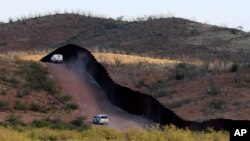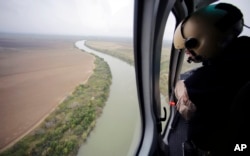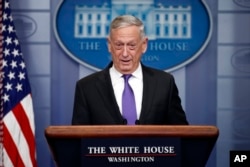President Donald Trump said Thursday that he would send 2,000 to 4,000 National Guard troops to the U.S. border with Mexico.
Speaking to reporters aboard Air Force One, Trump said he would keep the troops there until a border wall was built to keep out what his administration described as a surge in the number of attempted illegal border crossings.
Meanwhile, both the White House and the Pentagon said discussions about specifics for the enhanced U.S. military presence along the country's southwestern border were ongoing, and that much would depend on the needs of the U.S. states along the border.
White House deputy press secretary Hogan Gidley, speaking earlier to reporters traveling with the president to West Virginia for a round-table discussion on tax reform, said of the troops sent to the border, "It's as many as we need, as many as it takes."
"The number one function of the federal government is to protect the American people," Gidley added.
Support cell formed
To facilitate the process, the Defense Department on Thursday announced the formation of a new border security support cell, based out of the Pentagon, to serve as a single point of contact between the Pentagon and the Department of Homeland Security, which has the lead on Trump's border security initiative.
But even basic questions, such as the troops' responsibilities and whether they will be paid by the Pentagon or by the states, have not been answered.
"We literally have just stood this up," Chief Pentagon spokeswoman Dana White told reporters during a briefing Thursday. "This is a priority and the secretary [Jim Mattis] considers it a priority."
Lawmakers concerned with cost
Some lawmakers have raised concerns that in order to pay for the additional troops, the Pentagon will have to pull money from other, critical programs, including those for maintenance and safety upgrades.
White said the source of the money should not be a concern.
"I can assure you that our resources will still be dedicated to making sure our warfighters get what they need when they need it," she said.
Defense officials say once they hear from Homeland Security and the border states, they will be able to move ahead and quickly position troops and resources where they are most needed.
For now, the plan is to use the National Guard troops to support Customs and Border Patrol agents who are working in a law enforcement capacity.
Will troops be armed?
Whether any of the military troops will be armed, however, is still under consideration.
"Those are exactly the questions we're answering now," Lieutenant General Kenneth McKenzie told reporters.
"It will dependent on the situation," he added. "Our bias is always that soldiers are able to defend themselves. However, we're going to be guided by the dialogue going on right now between DHS and the governors."










